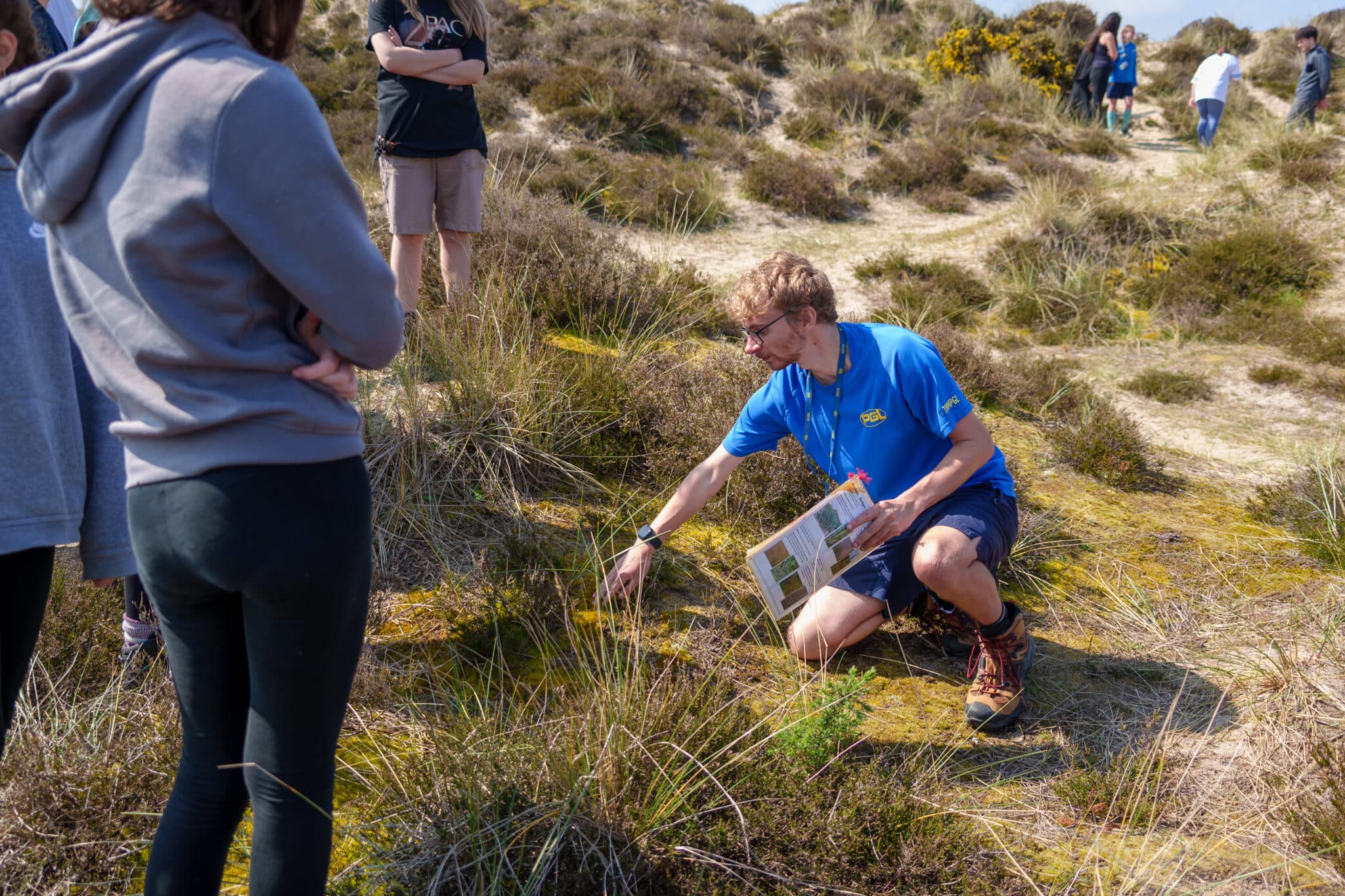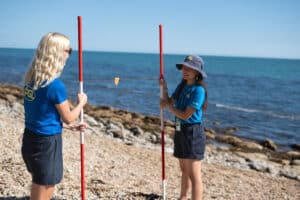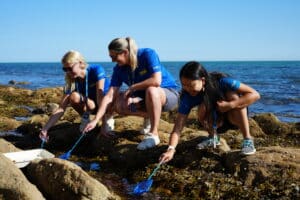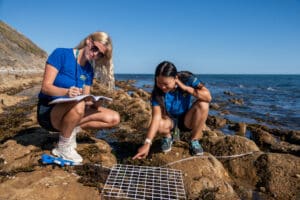Field trips offer students the chance to step outside the classroom and experience hands-on learning in real-world settings. For secondary school teachers, planning a field trip can be a valuable way to reinforce key concepts, spark curiosity, and enhance student engagement. Whether it’s collecting geographical data on a coastal visit, studying biodiversity in a nature reserve, or exploring mathematical concepts in an interactive museum, field trips bring subjects to life in ways that textbooks alone cannot.
In this guide, we’ll explore a range of educational field trip ideas for GCSE and A-Level students, covering core subjects like Geography, Biology, and Maths, as well as additional opportunities in History, Business Studies, Art, and Science. We’ll also cover practical tips for organising a successful school trip, from risk assessments to budgeting, ensuring your students get the most out of the experience.
Ready to learn more? Let’s dive in!
Why It’s Beneficial for Schools to Incorporate Field Trips into Studies
Field trips are more than just a break from the classroom, they are a powerful educational tool that enhances student learning and engagement. By stepping into real-world environments, students can apply theoretical knowledge to practical situations, deepening their understanding of key subjects and developing valuable skills.
- Enhances Student Engagement and Motivation – Learning outside the classroom stimulates curiosity and encourages participation. Many students find hands-on experiences more engaging than traditional lessons, which can help improve retention and make complex topics easier to grasp. Whether it’s investigating coastal erosion on a Geography trip or measuring angles in a real-world Maths application, fieldwork brings subjects to life.
- Supports Coursework and Exam Preparation – For GCSE and A-level students, field trips provide valuable opportunities for coursework and practical assessments. Many subjects, such as Geography and Biology, require students to collect and analyse data, making field trips an essential part of the curriculum. By gathering first-hand observations, students gain insights that they can apply to their coursework, case studies, and exam questions.
- Develops Critical Thinking and Problem-Solving Skills – Experiential learning helps students develop problem-solving and analytical skills. Field trips often involve real-world challenges, such as measuring environmental impact, interpreting historical artefacts, or calculating distances. These experiences encourage students to think critically, ask questions, and draw evidence-based conclusions.
- Encourages Teamwork and Communication – Many field trip activities require students to work in groups, whether they’re collecting scientific data, completing a scavenger hunt in a museum, or navigating a historical site. These experiences promote collaboration, communication, and leadership skills, which are essential both in education and in future careers.
- Provides Exposure to Career Paths and Real-World Applications – Field trips introduce students to potential career opportunities in different industries. A visit to a science lab, a financial hub, or an environmental conservation site can spark interest in STEM careers, business, or sustainability. Meeting professionals and seeing subjects applied in real-world settings can help students make informed choices about their future studies and career paths.
- Breaks Up the Routine and Improves Well-Being – Taking learning beyond the classroom reduces stress and improves student well-being. A change of environment, especially one that involves outdoor learning, can be refreshing, which helps students stay motivated and engaged with their studies. Studies have shown that outdoor and experiential learning can improve concentration, mental health, and overall academic performance.
By incorporating field trips into the curriculum, schools can provide students with enriching, memorable learning experiences that support both their academic progress and personal development.
Practical Considerations When Planning A School Field Trip
Organising a school field trip requires careful planning to ensure a smooth, educational, and enjoyable experience for students. From securing permission to managing logistics, there are several factors teachers need to consider. Here’s a step-by-step guide to help you plan a successful trip.
- Aligning the Trip with the Curriculum
- Before choosing a location, ensure that the trip aligns with the learning objectives of your subject. Whether it’s a Geography field study, a Biology conservation visit, or a Maths-focused day at an interactive science centre, the trip should reinforce key topics covered in the classroom.
- Securing Permissions and Risk Assessments
- School Approval – Get approval from your school’s leadership team early in the planning process.
- Parental Consent – Send out letters or emails detailing the trip’s purpose, itinerary, costs, and safety measures.
- Risk Assessment – Identify potential risks (e.g., weather conditions, transportation, student supervision) and develop a mitigation plan. Many venues provide their own risk assessments, which can be useful when filling out school documentation. If organising through a company, make sure to check their accreditation, for example, whether they are an LOtC Quality Badge holder to show their commitment to child safety.
- Budgeting and Funding Options
- Cost per student & cost for the leaders – Consider entry fees, travel costs, accommodation (if applicable), and meals.
- School Funding – Some trips may qualify for school budgets or grants, reducing costs for students.
- Student Contributions – Be transparent about costs and offer payment plans if needed.
- Transport and Logistics
- Mode of Transport – Coach hire is common for school trips, but public transport may be a cheaper alternative for urban trips. If you have a coach company that regularly works with your school, they may be able to offer a competitive quote!
- Journey Time – Factor in realistic travel times and potential delays.
- Accessibility – Ensure the trip location is accessible for all students, including those with additional needs.
- Supervision and Staffing
- Staff-to-Student Ratio – Check your school’s policy on supervision requirements. Most secondary school trips require at least one teacher per 10-15 students, but this may vary depending on factors such as students with additional needs.
- First Aid – Ensure a trained first aider is part of the supervising team and that a first aid kit is available.
- Emergency Contacts – Have a list of emergency contacts for all students and staff.
- Student Preparation and Behaviour Expectations
- Pre-Trip Briefing – Go over the trip itinerary, safety guidelines, and expected behaviour with students.
- What to Bring – Provide a checklist of essentials (e.g., packed lunch, appropriate clothing, notebooks for data collection).
- Code of Conduct – Reinforce school behaviour policies and any specific rules for the trip location.
- Medical or Dietary requirements – Make sure to check if students have any medical or dietary requirements that need to be monitored during the trip.
- Post-Trip Follow-Up
- Debriefing and Reflection – Encourage students to reflect on their experiences and how they link to their studies.
- Assessments and Reports – If the trip involved data collection or coursework, schedule time to analyse findings back in the classroom.
- Feedback for Future Trips – Gather feedback from students and staff to improve future trips.
By carefully considering these practical elements, teachers can ensure their field trips are not only educational but also safe, well-organised, and enjoyable for everyone involved.
School Field Trip Ideas For Core Subjects
Field trips provide students with valuable opportunities to apply classroom learning to real-world environments. Whether studying coastal erosion first-hand, collecting biodiversity data in a nature reserve, or exploring mathematical principles in action, subject-specific trips help bring theoretical concepts to life. Below are some engaging field trip ideas tailored to the core subjects of Geography, Biology, and Maths, along with key topics covered in each.
Geography
One of the best field trip ideas is going on a Geography adventure. You have the opportunity to bring students’ learning to life by showing them geographical features, as well as allowing them to conduct experiments and research and become real Geographers. They’re great for putting their learning into action!
Here are some topics that you might cover:
- Settlement Investigation – Why do towns and cities develop where they do? Students can investigate land use, population patterns, and urban growth by mapping out local areas, studying regeneration projects, or assessing the impact of industry and transport networks.
- Freshwater Pollution – By collecting and testing water samples from rivers, lakes, or wetlands, students can examine pollution levels, looking at factors like pH, nitrates, and turbidity. This helps them understand the human impact on water quality and the importance of conservation efforts.
- Map Skills – Navigating with topographic maps, using grid references, and interpreting contour lines become much more engaging when applied in the real world. Students can even incorporate GPS and GIS technology for digital mapping exercises.
- Geology – A hands-on look at rock formations, soil composition, and erosion can give students a deeper understanding of how landscapes evolve over time. They can analyse different rock types, weathering processes, and the effects of natural forces on landforms.
- Coastal Management – How do we protect coastlines from erosion? Students can examine real-world coastal defence strategies like sea walls, groynes, and managed retreat, weighing their effectiveness and considering environmental and economic impacts.
- Coastal Processes and Features – From towering cliffs to shifting sand dunes, the coastline is constantly changing. Students can observe landforms shaped by erosion and deposition, measure wave activity, and track sediment movement to see how these processes shape the shore.
- Urban Settlements – Cities are always evolving. Students can analyse urban expansion, transport systems, and sustainable planning efforts by conducting pedestrian counts, assessing traffic flow, or investigating housing developments.
- Rivers – By measuring river depth, velocity, and sediment size, students can see first-hand how water shapes the landscape. They can explore processes like erosion and deposition, assess flood risks, and evaluate different flood management techniques.
Geography field trips offer students the chance to move beyond textbooks and experience the subject firsthand. Whether they’re investigating urban settlements, measuring river velocity, or exploring coastal landforms, these hands-on experiences bring learning to life in a way the classroom simply can’t.
At PGL, our Geography KS3, Geography GCSE, and Geography A-Level trips are designed to support the curriculum while making fieldwork exciting and memorable.
Biology
Mother Nature is a classroom in itself. Another one of the greatest field trip ideas is taking students on a Biology trip. Students can get hands-on with fieldwork, exploring wildlife and marine life on the coasts, identifying potential habitats, and lots more.
As well as all the exciting practical work that you can conduct on a trip like this, there’s also potential for recording theories and creating research pieces. Students can collect data during their field trip lessons and produce their own case studies.
Some Biology field trip ideas and topics that you might cover include:
- Ecology – Students observe interactions between organisms and their environment, identifying producers, consumers, and decomposers in food chains and webs. They may study abiotic factors like light, temperature, and soil moisture.
- Biodiversity – Using quadrats and transects, students can gather data on species distribution and abundance. They learn how biodiversity is measured, why it is important, and what conservation efforts are in place to protect endangered species.
- Marine Zonation – Tidal zones offer a fascinating look at how different organisms adapt to changing conditions. Students can investigate marine species in rock pools, estuaries, or tidal flats, examining how factors like salinity, wave action, and tide levels influence biodiversity.
- Psammoseral Succession – Students study the ecological succession of sand dunes, from embryo dunes to established vegetation. They measure soil pH, plant species diversity, and how abiotic factors influence succession over time.
A Biology field trip turns the natural world into a living classroom, allowing students to explore ecosystems, conduct hands-on research, and deepen their understanding of key scientific concepts. Whether they’re studying biodiversity, marine life, or ecological succession, these immersive experiences help bring biology to life beyond the textbook.
At PGL, our Biology A-Level trips provide the perfect opportunity for students to apply their knowledge in real-world settings.
Maths
Who said you can’t bring maths to life? We use theories, calculations and data collection in our everyday lives, so why not apply it to some epic activities and get your students thinking? This is a great way to link learning to the real world, where students can see the value of maths and how it’s used.
Here are some topics that you could adopt when completing activities on a maths field trip:
- Trigonometry – Students use triangulation to measure the height of buildings, trees, or other structures. This helps them understand sine, cosine, and tangent functions in real-world applications.
- Data Collection – Fieldwork allows students to gather and analyse real-life data, such as pedestrian flow, vehicle speeds, or ticket sales at an event. They can apply statistical methods like mean, median, mode, and standard deviation.
- Algebra – Examining patterns in nature, construction, or finance can help students understand equations, sequences, and algebraic modelling. They might work on real-world problems like calculating mortgage repayments or the decay of radioactive materials.
- Ratios and Percentages – Students analyse financial transactions, scale models, or population growth. Understanding percentages is crucial for topics like profit margins, discounts, and interest rates.
- Angles – Exploring the role of angles in engineering, architecture, and design. Students can measure and calculate angles in bridges, buildings, or even sports pitches.
- Multiplication, Addition, Division, and Subtraction – These fundamental operations can be applied to budgeting, measuring materials for construction projects, and analysing sports statistics.
- Distance/Speed/Time Calculations – Exploring how these mathematical principles apply to transportation, athletics, and physics. Students might calculate the speed of vehicles, analyse marathon times, or determine the efficiency of public transport.
A math field trip is the perfect way to take learning beyond the classroom and show students how numbers shape the world around them. Whether they’re measuring angles in architecture, collecting real-world data, or applying trigonometry to towering structures, these hands-on experiences make math exciting, relevant, and fun.
At PGL, our Maths KS3 trips are designed to inspire young mathematicians through practical, real-world applications.
Other Subjects to Consider
While Geography, Biology, and Maths are common subjects for field trips, other disciplines can also benefit from real-world learning experiences:
- History – Visits to museums, battlefields, and historical landmarks help bring the past to life.
- Business Studies – Behind-the-scenes tours of manufacturing plants, stock exchanges, and marketing firms provide insight into real-world business operations.
- Art and Design – Trips to galleries, design studios, and sculpture parks inspire creativity and critical thinking.
- Science – Visits to laboratories, science museums, and space centres allow students to see scientific principles in action.
Book a Field Trip with PGL!
Inspired by these field trip ideas? At PGL, we offer a wide range of residential school trips designed to bring learning to life through adventure, exploration, and hands-on experiences. Whether your students are delving into geography, biology, maths, or a self-taught field trip, we have programmes tailored to support their learning outside the classroom.
From adrenaline-fuelled activities to immersive educational experiences, our trips offer something for every student. We cater to both primary and secondary schools, with locations across the UK to suit your needs.
Take a look at some of our programmes:
- Football Coaching
- Netball Tournaments
- Ardèche Adventure
- French Package
- R.E.A.C.H. – UNITE!
- R.E.A.C.H. – GROW!
- Revision Weekends
- Geography A-Level
- Ski & Snowboarding
With so many incredible trips, locations, and activities to choose from, we’re here to help you plan an unforgettable experience for your students. Get in touch today to start planning your next school trip!





